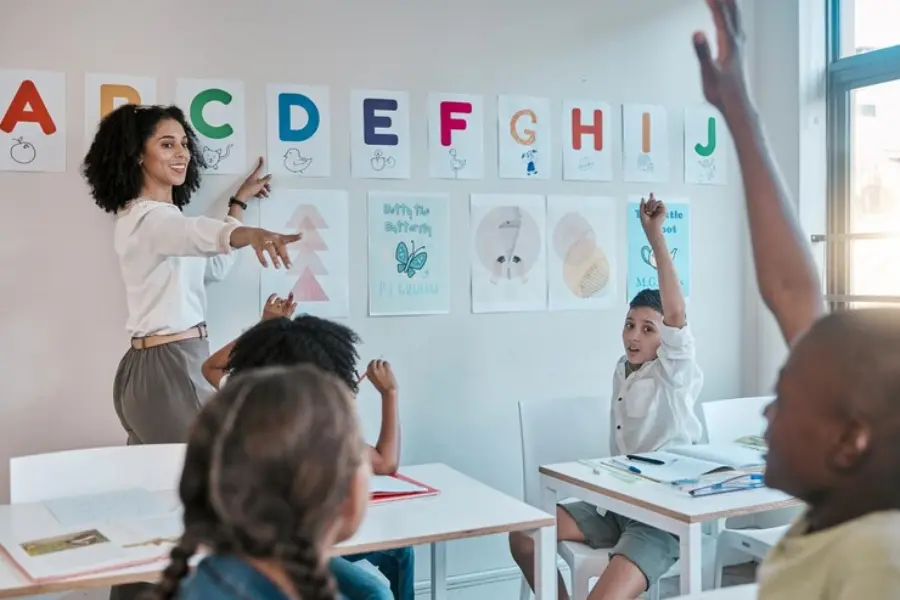
Source: freepik
To develop strong literacy skills in children, picking the perfect Phonics Teaching Program is vital. A well-structured program promotes reading by focusing on letters and sounds, helping learners interpret words effectively. Among the available options, Vidhyanidhi Education Society stands out with its methodical approach to Phonics Teaching, offering expert-designed Phonics Teaching courses that ensure valuable and engaging learning experiences for educators and students alike.
What is the Correct Order of Phonics Teaching?
Phonics Teaching in a methodical sequence helps children develop fundamental reading and writing skills effectively. With this, learners systematically grasp the connection between letters and sounds, thus progressively building a robust foundation for literacy.
Below is a detailed breakdown of the Correct Order of Phonics Teaching, including key phases and concepts:
Phase 1: Letter Sounds
- Familiarize individual letter sounds with children, concentrating on both recognition and pronunciation.
- Begin with the letters S, A, T, P, I, and N, as they are adaptable and can be merged to form simple words such as ‘sit,’ ‘pan,’ ‘tin,’ etc.
- Motivate children to relate each letter with its related sound through repetitive practice.
- Teach proper letter formation to ensure they can write these letters accurately.
- Use visual aids, flashcards, and engaging activities to reinforce their understanding of letter sounds.
Phase 2: Blending and Segmenting
- Teach children to blend individual sounds to form whole words. For instance, blending the sounds /s/, /i/, and /t/ to say ‘sit.’
- Simultaneously, familiarize children with segmenting, where children split down words into their individual sounds. For instance, the word “lot” can be segmented into /l/, /o/, and /t/.
- Use hands-on techniques such as sound boxes or tapping out sounds to make this phase interactive and enjoyable.
Phase 3: Decoding
- Acquaint children with basic three-letter words, often referred to as CVC (consonant-vowel-consonant) words, like ‘cat,’ ‘bit,’ ‘mug,’ etc.
- Slowly expose them to complicated words.
- Focus on building confidence in interpreting unfamiliar words by motivating them to sound out each letter or phoneme.
Phase 4: Digraphs
- Teach digraphs, which are two letters that merge to produce one sound, such as ‘ch,’ ‘sh,’ ‘th,’ etc.
- Assist children in identifying these digraphs within words and decode more complex words using them.
- Focus on spelling and reading polysyllabic words during this stage to improve their vocabulary and comprehension skills.
Phase 5: Alternative Graphemes
Introduce alternative graphemes, where the same sound (phoneme) can be represented by different letter combinations.
For example
- /ai/ as in “rain.”
- /ay/ as in “day.”
- /a-e/ as in “cake.”
Help children identify and apply these variations in their reading and writing. This phase expands their ability to read diverse texts with confidence.
Additional Phonics Concepts
Beyond the main phases, certain advanced phonics concepts are essential for a comprehensive understanding:
R-Controlled Vowels
Guide how vowels act differently when pursued by the letter “r,” such as ‘car,’ ‘her,’ etc.
Syllable Types
Familiarize syllable structures like open (e.g., “go”) and closed (e.g., “cat”) to enhance reading proficiency.
Hard and Soft C & G Sounds
Illustrate distinct pronunciation, such as hard “c” in “cat” and soft “c” in “city.”
Silent Letters
Emphasize words with silent letters like “kn” in “knife” or “wr” in “write.”
W-Influenced Words
Teach how “w” alters vowel sounds, as in “what,” “who,” etc.
This methodical and engrossing approach to Phonics Teaching lays a solid groundwork for literacy, helping children evolve into confident readers and writers.

Source: freepik
What are Phonics Lesson Plans?
Phonics Lesson Plans are methodical guides prepared for systematic teaching of the association between sounds and letters. These Phonics Lesson Plans help educators in effective Phonics Teaching and deliver lessons that build robust reading and writing skills in children. Integrating various aspects of Phonics Teaching ensures that learners comprehend, practice, and use phonics concepts effectively.
Below is a breakdown of the key components of well-structured Phonics Lesson Plans:
Phonemic Understanding Warm-Up
Start Phonics Teaching with exercises focused on phonemic understanding, such as recognizing sounds in words, rhyming, or segmenting words into individual sounds. This trains students to focus on the exact phonics skill being taught.
Introduction/Review of Sound/Spelling(s)
Introduce new sounds or review previously learned ones. Use visual aids, sound charts, or flashcards to associate sounds with their corresponding spellings.
Blending Practice
- Help students practice blending individual sounds to form words.
- For instance, illustrate blending the sounds /c/, /a/, and /t/ to say “cat.”
- Motivate students to practice blending alone or in small groups.
Word Work
- Focus on building vocabulary by practicing words that feature the targeted sound or spelling pattern.
- Use activities like sorting words into categories, finding similar patterns, or spelling exercises.
Decodable Text Reading
- Provide students with decodable text that aligns with the sound or spelling pattern being taught.
- Allow students to practice reading these texts aloud, which helps reinforce their decoding skills and boosts confidence.
Dictation Practice
End the lesson with dictation exercises where students write words or sentences using the sound or spelling learned.
This step enhances their ability to spell accurately and reinforces the connection between sounds and letters. Phonics Lesson Plans are essential tools for ensuring consistency and progress in Phonics Teaching. By integrating activities like blending, word work, and dictation, these Phonics Lesson Plans cater to various learning styles and help students master the fundamental building blocks of literacy.
Choose Vidhyanidhi Education Society and master phonics teaching with confidence!
For more details of Phonics Course Call / Whatsapp +919869866277/+919869546913
To Download Brochure of Phonics Course, Click Here!
Phonics Course
FAQs
What is the Best Method to Teach Phonics?
The best method is systematic phonics, teaching letter sounds in order, blending, segmenting, and practical application to build reading and spelling skills effectively.
Which Sounds to Teach First?
Start with simple consonants and short vowel sounds, focusing on letters like S, A, T, P, I, N, which help form basic words early on.
How to Start Phonics Classes?
Begin by introducing sounds with engaging activities, teaching blending and segmenting, using visual aids, and providing hands-on practice with phonics materials.



